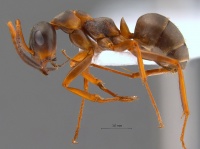Formica persica
| Formica persica | |
|---|---|

| |
| Scientific classification | |
| Kingdom: | Animalia |
| Phylum: | Arthropoda |
| Class: | Insecta |
| Order: | Hymenoptera |
| Family: | Formicidae |
| Subfamily: | Formicinae |
| Tribe: | Formicini |
| Genus: | Formica |
| Species: | F. persica |
| Binomial name | |
| Formica persica Seifert & Schultz, 2009 | |
Occurs in highly diverse habitats from steppe, human settlements, rural areas, river sides, and frequently inside of forests. The forest sites are below 1000 metres and include deciduous and Juniperus forests. (Seifert and Schultz 2009)
Identification
Seifert and Schultz (2009) - It is unknown if there are contact areas with the Anatolian and Caucasian population of F. cunicularia.
Keys including this Species
Distribution
Seifert and Schultz (2009) - Known from the North Iranian region of the Elburs Mountains between 48.5° to 56° E and 36.2° to 38.4° N, in a region with much precipitation (600 - 1500 mm per year). Altitudinal range from sea level up to 2300 metres.
Latitudinal Distribution Pattern
Latitudinal Range: 38.4° to 36.17°.
| North Temperate |
North Subtropical |
Tropical | South Subtropical |
South Temperate |
- Source: AntMaps
Distribution based on Regional Taxon Lists
Palaearctic Region: Iran (type locality).
Distribution based on AntMaps
Distribution based on AntWeb specimens
Check data from AntWeb
Countries Occupied
| Number of countries occupied by this species based on AntWiki Regional Taxon Lists. In general, fewer countries occupied indicates a narrower range, while more countries indicates a more widespread species. |

|
Estimated Abundance
| Relative abundance based on number of AntMaps records per species (this species within the purple bar). Fewer records (to the left) indicates a less abundant/encountered species while more records (to the right) indicates more abundant/encountered species. |

|
Biology
Castes
Nomenclature
The following information is derived from Barry Bolton's Online Catalogue of the Ants of the World.
- persica. Formica persica Seifert & Schultz, 2009: 268, fig. 10 (w.) IRAN.
Unless otherwise noted the text for the remainder of this section is reported from the publication that includes the original description.
Description
Worker
Medium-sized Serviformica species (CS 1.332 mm), head and scape much longer than in Formica cunicularia (CL / CW1.4 1.162, SL / CS1.4 1.152). Petiole rather wide (PEW / CS1.4 0.450). Distance between lateral ocelli moderate (OceD / CS1.4 0.162), eye medium-sized (EYE / CS1.4 0.297). Clypeus with sharp median keel and fine longitudinal microcarinulae. Frontal triangle finely transversely rippled and with 45 - 85 short pubescence hairs. Eyes with microsetae of 9 μm maximum length. Pronotum, mesonotum, petiole, flexor profile of hind tibia, posterior margin of head, propodeum, and dorsolateral metapleuron normally without setae. Ventral coxae with long setae, setae on dorsum of first gaster tergite sometimes lacking. Dorsal mesonotum in lateral aspect broadly convex, but in small ants flatter. Metanotal depression in larger specimens deep, in small specimens shallow. Propodeal dome in profile obtuse-angled or rounded. Dorsal crest of petiole in frontal view convex, sometimes obtuse-angled. Petiole scale in lateral aspect slender, with convex anterior and more straight posterior profile. Mean distance of transverse microripples on dorsum of gaster larger than in F. cunicularia (RipD 5.8 μm). Gaster covered by a dense silvery pubescence (sqPDG 3.3). Pubescence on head, mesosoma and petiole less dense, ants appear somewhat shiny. Posterior vertex, often dorsal promesonotum, coxae, and all appendages brown, gaster always dark brown. Other body parts yellowish-reddish.
Type Material
Holotype worker plus 6 worker paratypes (4 stored in ethanol) labelled “IRAN: 36.767°N, 54.567°E, Tuskestan forest, 900 m Juniperus forest O.Paknia 2005.09.23-517” and “Holotype Formica persica Seifert & Schultz” / “Paratype Formica persica Seifert & Schultz”; SMN Görlitz.
Etymology
From Persia – the terra typica of this species.
References
- Seifert, B. and R. Schultz. 2009b. A taxonomic revision of the Formica rufibarbis Fabricius, 1793 group (Hymenoptera: Formicidae). Myrmecologische Nachrichten. 12:255-272.
- Borowiec, L. 2014. Catalogue of ants of Europe, the Mediterranean Basin and adjacent regions (Hymenoptera: Formicidae). Genus (Wroclaw) 25(1-2): 1-340.
References based on Global Ant Biodiversity Informatics
- Borowiec L. 2014. Catalogue of ants of Europe, the Mediterranean Basin and adjacent regions (Hymenoptera: Formicidae). Genus (Wroclaw) 25(1-2): 1-340.
- Seifert B., and R. Schultz. 2009. A taxonomic revision of the Formica rufibarbis Fabricius, 1793 group (Hymenoptera: Formicidae). Myrmecological News 12:255-272.

